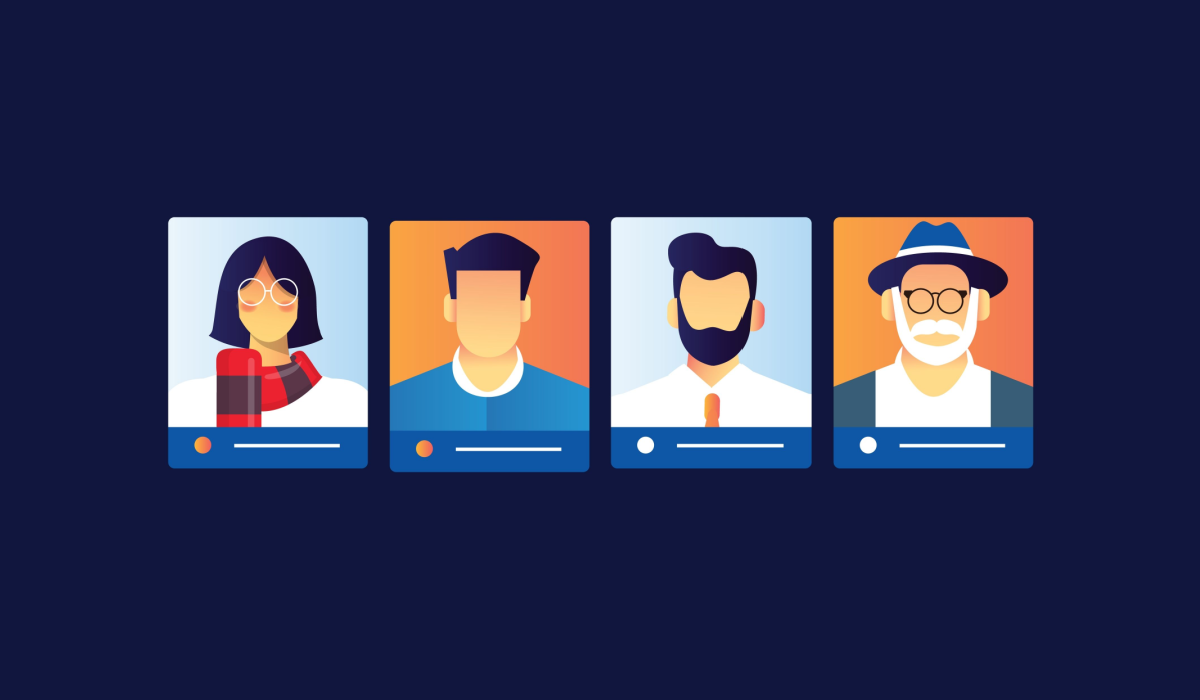If you’re listening to a coach, professor, or sales dude explain the ins and outs of selling a product, at some point, they’re going to tell you to make a buyer persona.
But, another figure in the selling sanctum of knowledge might tell you to make a customer persona.
Or a customer profile.
Maybe a customer avatar or ideal customer?
How many of these profiles or personas do you have to make to determine who you’re selling to?
Ironically, all these terms get used interchangeably, but they are different. And unfortunately for all of us, the swapping of terminology makes it all confusing to the point where we don’t know who to trust.
Let’s remove the confusion by defining what a buyer persona and its associated terms mean.
And more importantly, we’ll provide templates for using them in your business. Because a persona, profile, or avatar is only as good as your plan to use the damn thing.
Defining Buyer Persona, Customer Persona, and the Like
Okay, let’s start with the definitions. The simplest way to break these terms down is to view them as a dartboard, beginning with the widest edge of the target to the inner circle. The closer you get to the bullseye, the more pinpoint you can define a customer.
Before we start with persona terms, let’s describe the broadest definition to view customers you’re trying to reach for your business–the target market.
Don’t Skip: The Guide to Defining Your Target Market
Target Market
A target market is a specific group of people interested in a business’s products or services. People who fall into your target market likely share similar characteristics—whether that means demographic similarities, shared preferences or values, geographic locations, or buying power.
- Use Case: Target market research helps at the beginning of your business or a new product launch to create a snapshot of the people you’re trying to reach.
- The Problem It Solves: Developing a target market helps you consider who would use your product or service.
Ideal Customer
An ideal customer is someone within your target market who you hope will buy your product or use your service. Your ideal customer is the type of person you imagine interacting with your business, purchasing your product, and building your business.
- Use Case: Typically, an ideal customer will be an outcome while researching your target market. Ideal customers are described at a high level, like women in their 40s that love yoga and maintain a healthy lifestyle.
- The Problem It Solves: An ideal customer gives you a vision of who you’re trying to reach and will influence decisions in the marketing and product development process.
Buyer Persona
A buyer persona (also known as ideal consumer persona or buyer avatar) is a detailed description of an imaginary person you believe in primed to purchase from you BUT has not yet. You can create a buyer persona using data from your target market, competition, or consumer reports.
Use Case: Buyer personas are documents for developing a go-to-market strategy for a business or product launch.
The Problem It Solves: Buyer personas help your business focus its sales and marketing on a specific type of person. For example, instead of creating a social media ad targeting women in their 40s, you can create a more targeted ad for women in their 40s shopping for portable yoga mats.
A buyer persona includes:
- An imaginary name (have fun with this)
- Age
- Location
- Job and title
- Income
- Interests, hobbies, day-in-the-life
- Pain points and struggles
- The purchasing behavior of competitors or like products
- Communication preferences (social media, email, SMS)
Customer Persona
Whereas a buyer persona makes assumptions about someone who could become a customer, a customer persona assumes information about what happens when a person becomes your customer. As a result, customer personas (also known as customer personas or avatars) help you predict what your customers need once they’ve made a purchase.
- Use Case: Customer personas are documents that forecast what your customer service and sales teams need to fulfill with customers. Customer personas are especially helpful if you have a B2B business or have a long selling cycle.
- The Problem It Solves: Customer personas will allow you to set up your customer service and inside sales teams with the information of what questions and concerns they need to meet for future customers.
A customer persona includes the same information as a buyer persona with the additions of:
- What products or services the customer purchased
- How they purchased
- When they purchased
- What marketing tactics worked
- How they interact with the brand
- Additional sales conversations
User Persona
A user persona (also known as a user avatar) is a fictional makeup of a customer that uses a product or service long-term.
- Use Case: User personas are helpful in customer service training, product implementation, and IT strategy.
- The Problem It Solves: If you have a subscription product or SaaS business, user personas help you describe the type of people using your product.
A user persona includes the same information as a customer persona with the addition of:
- Subscription or membership level
- What aspects of the product or service a customer uses
- How much do they use the product or service
- What problems are they facing with the product or service
- Renewal period
Customer Profile
A customer profile (also known as a consumer profile) is a detailed document that defines the makeup of your current customer using sales data and psychographics. Unlike ideal customer or buyer personas, a customer profile is an internal tool to describe your customers instead of assuming or guessing who they are.
- Use Case: This is used internally across departments and teams to better understand the current customer. In addition, you can store customer profiles in a CRM tool.
- The Problem It Solves: Correcting assumptions about the current customer so your team can optimize customer service, sales, or marketing issues.
A customer profile includes:
- Bio
- Demographics
- Purchase history
- Application product/service use
- Customer journey
- Communication preferences
- Goals
- Pain points
- Behaviors
- Interviews
- Reviews
Buyer Persona Templates and Examples
Below are examples of a buyer persona, customer persona, and customer profile so you can copy, paste, and customize for your business. We’ll focus these templates on an ecommerce business that sells refurbished yoga mats and equipment called Matra (sorry, not sorry about the business name pun).
Buyer Persona Template and Example
- Name: Sue Supine
- Age: 36 years old
- Location: Toronto, Canada
- Job and title: Senior data analyst for a national bank
- Interests/Hobbies: Triathlete. She loves hanging out with friends and going out on the town. Vegetarian and environmentally conscious. Volunteers at a local animal shelter.
- Lifestyle: Single with two cats. She travels for work and lives in a skyrise condo downtown.
- Pain Points: Sue is getting into yoga to help curb the wear and tear on her muscles from triathlon training. She currently uses a mat through her new yoga gym but is shopping for a portable yoga mat to bring when she travels.
- Purchasing Behavior: Sue buys products from environmentally conscious brands that she mainly finds through Instagram or word of mouth.
- Communication Preferences: Instagram and personal email (that she checks infrequently).
Customer Persona Template and Example
- Purchased: Recycled travel yoga mat (best-seller)
- How: Through a targeted ad with a 10% promo code.
- When: On the second to last day of the 10% off campaign.
- What: Instagram Stories ad that showed an influencer using the product.
- Interaction: Followed the Instagram account before purchase.
- Additional: Sent follow-up purchase email and started onboarding email process.
Customer Profile Template and Example
We’ll continue using the example of Sue and Matra, but if she was an actual customer and Matra was a real business.
Customer Profile Example: Sue Supine
- About: Sue Supine is a professional data analyst and heard about Matra through an Instagram campaign offering 10% off. She travels for work and appreciates the versatility of the recycled travel yoga mat.
- Age: 36
- Location: Toronto, Canada
- Job: Data analyst, InGen Corporation
- Household: Single
- Birthday: February 9, 1987
- First Purchase: May 29, 2023
- Follows Us: Instagram, email
- Sue’s Dreams: To practice yoga so she can compete in triathlons until she’s 60
- Sue’s Challenges: Her current yoga gym doesn’t offer online classes, which is frustrating because she travels for work.
- Things to Watch Out For: Sue’s email open rates are below average. Remarketing through Instagram might be a better option to reach her.
- Opportunities: Contact Sue to opt her into our trial online yoga program. Audit her social media to see if she’d be interested in joining our ambassador program.
Keep Learning: How to Write Your Unique Value Proposition (Tips + Examples)
Time to Execute
Now that we’ve cleared up the difference between buyer persona, customer persona, and customer profile, it’s time to use them.
For more detailed steps on how to start and grow your business, check out our free training, where you’ll learn everything from developing your first product to launching a marketing campaign.
The post Buyer Persona vs. Customer Profile. What’s the Difference and Why It Matters? appeared first on Foundr.




